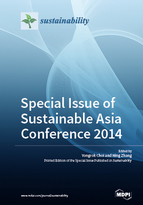Special issue of Sustainable Asia Conference 2014
A special issue of Sustainability (ISSN 2071-1050).
Deadline for manuscript submissions: closed (30 July 2014) | Viewed by 94796
Special Issue Editors
Interests: energy & environment (E&E); e-Business
Special Issues, Collections and Topics in MDPI journals
2 Institute of Poyang Lake Eco-economics, Jiangxi University of Finance and Economics, Nanchang 330013, China
3 Faculty of Geosciences and Environmental Engineering, Southwest Jiaotong University, Chengdu 611756, China
Interests: environmental economics; energy economics
Special Issues, Collections and Topics in MDPI journals
Special Issue Information
Dear Colleagues,
This Special Issue will consist of selected papers from the Sustainable Asia Conference 2014, an international conference held in Nanchang, China, during April 23-25, 2014. SAC 2014 is one of the leading international conferences for presenting novel and fundamental advances in Sustainable Development issues for Asia. The purpose of the conference is for scientists, scholars, engineers, and students from universities and research institutes around the world to present ongoing research activities, so as to promote global research networking in the sustainable development area. This conference provides opportunities for the delegates to exchange new ideas and application experiences face to face, to establish research or business relations, and to find global partners for future collaboration. The scope of this Special Issue encompasses topics related to sustainable development and management at both the macro- and micro-levels in Asian countries
Prof. Dr. Yongrok Choi
Dr. Ning Zhang
Guest Editors
Notes for Prospective Authors
Selected papers from the Sustainable Asia Conference (SAC 2014) will primarily be considered for publication. Besides these, there may be a separate “open call for submission of papers”. The proposed papers should neither have been previously published nor be under active consideration for publication elsewhere. All submissions should meet Sustainability author guidelines (http://0-www-journals-elsevier-com.brum.beds.ac.uk/technological-forecasting-and-social-change/call-for-papers/sustainable-e-governance-in-northeast-asia-challenges-for-su/)
Important Dates
Papers that are currently under preparation are welcome, but we also expect papers to be written as a result of this call. The deadline for submission is July 31, 2014. Early submission is strongly recommended. The refereeing process starts once the paper is received (starting from April 30, 2014).
1) Submission date for authors: April 30, 2014
2) Deadline for manuscript submission for review: July 31, 2014
3) Expected date for fully refereed and revised papers to be delivered for production: September 30, 2014
4) Target Publication Date: November 30, 2014
Manuscript Submission Information
Manuscripts should be submitted online at www.mdpi.com by registering and logging in to this website. Once you are registered, click here to go to the submission form. Manuscripts can be submitted until the deadline. All submissions that pass pre-check are peer-reviewed. Accepted papers will be published continuously in the journal (as soon as accepted) and will be listed together on the special issue website. Research articles, review articles as well as short communications are invited. For planned papers, a title and short abstract (about 100 words) can be sent to the Editorial Office for announcement on this website.
Submitted manuscripts should not have been published previously, nor be under consideration for publication elsewhere (except conference proceedings papers). All manuscripts are thoroughly refereed through a single-blind peer-review process. A guide for authors and other relevant information for submission of manuscripts is available on the Instructions for Authors page. Sustainability is an international peer-reviewed open access semimonthly journal published by MDPI.
Please visit the Instructions for Authors page before submitting a manuscript. The Article Processing Charge (APC) for publication in this open access journal is 2400 CHF (Swiss Francs). Submitted papers should be well formatted and use good English. Authors may use MDPI's English editing service prior to publication or during author revisions.
Keywords
- sustainable development policy in asia
- sustainable business strategies and case studies in asia
- green growth and the low carbon economy in asia
- energy efficiency and greenhouse emission control in asia
- sustainable and governance-oriented it & e-business in asia
- sustainability indicators and new methodologies







